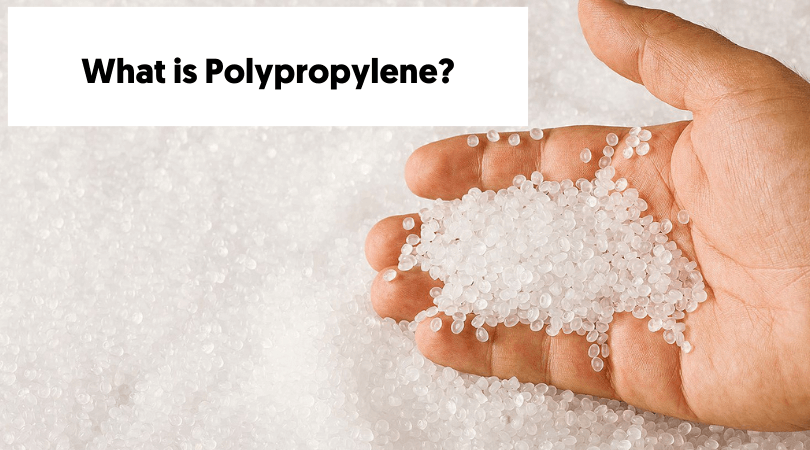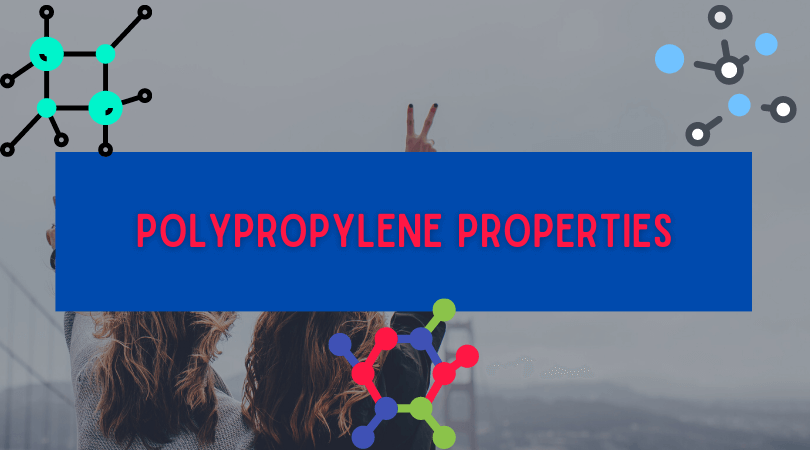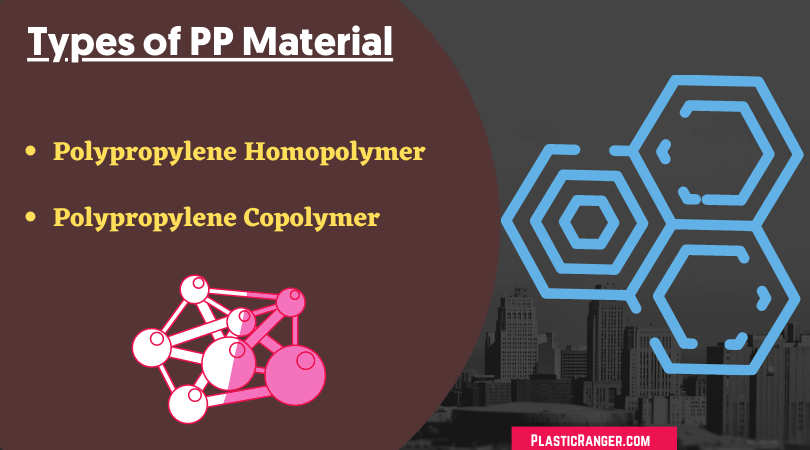PP is one of the most popular and mainstream plastic materials with endless applications. Let’s get into the details and know everything about the polymer.
What is Polypropylene Material?
Polypropylene, better known as PP, is a crystalline thermoplastic made of a blend of different polypropylene monomers.
It is known for its toughness and rigidness. Being resistant to many external factors makes Polypropylene one of the most used plastics in the manufacturing industry.
Polypropylene is broadly utilized in producing many products in various industries like automobiles, industrial, toys, healthcare, furniture, etc., throughout the world.

People wouldn’t even realize that most products they use daily are produced from Polypropylene plastic.
According to a study conducted by Fortune Business Insights, the global polypropylene industry’s size stood at USD 78.22 Billion in 2019 and is projected for profitable growth reaching USD 105.49 Billion by the year 2027.
Types of PP Material and Their Key Benefits
Two major polypropylene types are available in the global market: Homopolymers and Copolymers.
Polypropylene Homopolymer
It is the most extensively utilized general-purpose grade polypropylene type. It contains a propylene monomer in a semi-crystalline form.
The major applications are seen in textiles, packaging, pipes, healthcare, and electrical industries.
Polypropylene Copolymer
This Polypropylene family is divided into multiple random copolymers and block polymers. The family is created after polymerizing propane and ethane.
Polypropylene Random Copolymer
This variation of PP material is produced by polymerizing ethane and propane. The ethane units take about 6% of the total mass, accommodated randomly within the polypropylene chains.
These polymers have fantastic optical clearance and decant flexibility, making them suitable for producing visual products and products requiring significant physical presence.
Polypropylene Block Copolymer
This polypropylene is more rigid and less fragile compared to the random copolymer. That’s because of the 5% to 15% ethane content. The co-monomer are arranged in regular blocks.
Because of their high rigidness, these polymers are highly suitable for heavyweight industries like transportation and logistics.
- Impact Copolymer
- Expanded Polypropylene
- Polypropylene Terpolymer
- Polypropylene, High Melt Strength
Impact Copolymer
Impact copolymer is a combination of Propylene Homopolymer and Propylene Random Copolymer. The ethylene content is super high, at 45% to 65%.
Mainly utilized in manufacturing components requiring tremendous impact resistance. Thus, its properties as such make it highly suitable and heavily used in automotive and electrical applications.
Expanded Polypropylene
This PP material has a foam-like structure and appearance with very low density. The foam-like design makes it attractive to produce 3D polymer foam products.
It has an impressive higher strength-to-weight ratio, thermal conductivity, excellent impact resistance, and water and chemical resistance.
Expanded polypropylene is mainly used in construction, electrical, automobiles, and consumer goods.
Polypropylene Terpolymer
Polypropylene terpolymer comprises three chemicals: propylene segments, monomers ethylene, and co-polymer.
Its remarkable transparent properties and reduced crystalline uniformity make it the right choice for sealing film and related applications.
Polypropylene, High Melt Strength
It is what it sounds like. This polypropylene material blends melt strength and expandability fantastically. It has good chemical resistance and a slew of excellent mechanical properties, making it quite fitting for producing soft, low-density foams, food packaging, automobile, and construction verticals.
How is Polypropylene Made?
You may wonder how polypropylene is made
Polypropylene is synthesized from the monomer propylene. Making polypropylene involves several steps, including polymerization, extrusion, and finishing.
The first step is polymerization, where propylene monomer molecules are chemically bonded in a reactor vessel under high temperature and pressure, typically with a catalyst.
This results in a polymer chain with repeating units of propylene.
The polymer melt is then fed into an extruder, which is melted and shaped into pellets. These pellets are then cooled and transported for further processing.
In the finishing process, the polypropylene pellets are melted and shaped into a desired form, such as fibers, films, sheets, or molded parts, using injection or blow molding.
Additives can be introduced at this stage to modify the properties of the final product, such as color, stiffness, or resistance to UV radiation.
Fundamental Properties of Polypropylene

Polypropylene’s density is low and light in weight compared to other thermoplastics. It is one of the lightest commercially available polymers out there.
Thus making it suitable for lightweight product applications. Below I have shown the typical properties of polypropylene.
| Property | Value |
| Impact Strength | 2 – 6 kJ/m2 at 20 °C |
| Density | 1.04 – 1.06 g/cm3 |
| Melting Point | 160-168°C |
| Elastic Modulus | 1.5 – 3 GPa |
| Thermal Conductivity | 0.41 W/(m.K) at 20 °C |
| Flammability | UL 94 HB |
| Electrical Resistance | 1*1013 – 1*1014 Ω.m at 20 °C |
| Dielectric constant | 2.8 at 20 °C |
| Specific heat capacity | 1520 J/(kg.K) at 20 °C |
| Max. service temperature (short) | 140°C |
| Coefficient of thermal expansion | 6*10-5 – 1*10-4 1/K at 20 °C |
- Homopolymer Density: Ranges between 0.904 and 0.908 g/cm^3
- Random Copolymer Density: Also spans from 0.904 to 0.908 g/cm^3
- Impact Copolymer Density: Slightly lower, with a range of 0.898 to 0.900 g/cm^3
- Melting Point Differences:
- Homopolymer: Features a higher melting point, lying in the range of 160 to 165°C
- Copolymers: The melting point for these variants is generally lower, between 135 and 159°C
- Flammability: Polypropylene material is characterized by its notably high flammability, which must be considered in specific use cases.
- Chemical Resistance Profile:
- Excellent Resistance: Encountered when interacting with diluted acids, alcohol, and bases.
- Good but Lower Resistance: Exhibited towards aliphatic hydrocarbons, ketones, esters, and aldehydes.
Engaging Read – What is PEEK Material?
PP Processing Conditions

PP material is one of the most versatile thermoplastic processes to work with. It can be processed with virtually all the methods quite efficiently.
First, however, we will discuss Injection and Extrusion molding.
Injection Molding
Without any doubt, Injection Molding is the most compatible process for polypropylene.
Products like Household items, agriculture products, healthcare items, toys, vending machine components, electrical boxes, automotive products, etc.
- First of all, Dying is not essential if storage is done well.
- Mold Temp. – 10-80°C
- Melt Temp. – 200-300°C
- Mold shrinkage is primarily present, varying between 1.5 and 3%. The main factors affecting shrinkage are the processing conditions, polymer physics, and the finality of the part produced.
Extrusion Molding
Extrusion molding is also well-known for processing polypropylene. The second best after injection molding can manufacture plastic bottles, containers, household items, wires, pipes, etc.
- Compression Ratio: 3:1
- Melt temperature: 200-300°C
- Cylinder Temperatures: 180-205°C
- (221-230°F) , for regrinding
Advantages of PP material

- Water resistance is one of polypropylene’s key benefits, making it impenetrable. A quality that is extremely useful in industrial and medical applications.
- Good fatigue resistance also makes it eligible for use in products like live hinging and shampoo lits where bending is not allowed.
- Resistance to biological conditions like retrogression, fungi, algae, and bacteria.
- High electricity resistance is another handy benefit of polypropylene, making it compatible with manufacturing electrical components.
- Polypropylene is inexpensive compared to other thermoplastic materials like PET, PS, and LDPE.
- PP is entirely recyclable, making it even more inexpensive to process without hurting the environment.
How To Recycle PP?

The question at hand pertains to the complexities and nuances involved in recycling Polypropylene (PP).
The process commences with a critical step of removing all contaminants from the plastic waste set to be recycled.
The polymer undergoes a meticulous procedure wherein it is melted at a precise temperature of 250°C to ensure structural uniformity.
Following the melting stage, residual molecules are eliminated through a vacuum-based method to maximize purity.
Subsequently, the melted material undergoes solidification at a temperature of 140°C.
One way to enhance the quality of recycled PP is by amalgamating it with virgin PP, typically at a 50/50 ratio.
While this practice is common, it exposes an industry challenge: the minuscule proportion of recycled plastic incorporated into new products.
This is inherently tethered to consumption patterns and market demand for recycled materials. Nonetheless, PP remains a highly favored material for manufacturing many products.
This favorability is chiefly attributed to its minimal environmental footprint.
Unlike other polymers, PP exhibits a substantially lower level of toxicity, making it a comparatively greener option.
As for the end applications of recycled PP, it is impressively versatile.
The material finds extensive usage in creating functional items such as brooms, ice scrapers, and signaling devices.
In addition, it is also employed in more specialized applications, including the manufacturing of battery cables and battery cases.
This multi-faceted utility underscores the potential and importance of optimizing PP recycling processes.
Disadvantages of PP material

- High flammability
- Suspectable to oxidation
- Below-par bonding properties
- Suspectable to UV degradation
- Low resistance to chlorinated solvents and aromatics
Applications of Polypropylene
As discussed earlier, Polypropylene is a highly used thermoplastic material with various handy properties. It is widely used in many sectors.
- Automotive Industries
- Medical Applications
- Industrial Applications
- Fibers and Fabrics
- Consumer Goods
Automotive Industries
Polypropylene’s supreme moldability, resistance to bending, and outstanding mechanical properties like chemical resistance and decent wearability make it perfect for manufacturing automotive parts.
Main Applications include instrumental panels, door trims, fender lines, battery cases, boxes, trays, etc. for cars and trucks.
Medical Applications
Polypropylene has a massive influence on the medical industry because of its dozens of applications. High chemical and bacterial resistance is the main reason for that immense influence.
Additionally, Medical Grade PP demonstrates proper stream sterilization.
The most common application is medical syringes (Polypropylene has the leading market share for needles). Other critical applications include specimen bottles, diagnostic devices, food trays, pans, medical vials, Petri dishes, pill containers, prosthetics, etc.
Industrial Applications
Industrial applications are a significant chunk of polypropylene processing. Properties like corrosion resistance and good tensile strength are crucial in using PP extensively in industrial applications.
Polypropylene sheets manufacture products like tanks, pipes, packaging, etc.
Fibers and Fabrics
PP fibers and fabrics are utilized in many products like tapes, strapping, bulk filament, staple fibers, spun-bond, etc.
PP products are also considered fitting for marine applications because of their excellent water resistance.
Consumer Goods
PP material is often used in consumer goods to manufacturing products like Luggage, toys, furniture, etc. It is also used for packaging materials for fruits, veggies, and meats.
History of Polypropylene
The story of the origination of polypropylene materials is quite interesting. The first commercially available polypropylene enzyme was found in 1954 by an Italian chemist, Guilio Natta, and his assistant Paolo Chini.
At that time, they were associated with Montecatini Company (now Montedison SpA). They used multiple catalysts invented by another noted German chemist Karl Ziegler for synthesizing polyethylene.
Natta and Zieglar won a global price in chemistry for their invention in 1963.
The commercial production of polypropylene was started in 1957 by Hoechst AG in West Germany (now in Germany).
Commercial production kicked off in the early 1980s when a more stable version of the material was available in the free market. Japanese Mitsui Petrochemical Industries, Ltd developed it.
The Future of Polypropylene
[visualizer id=”1087″]
Source: MRFR analysis
According to a notable research organization, Polaris Research, the global polypropylene market will reach USD 120.11 Billion by 2026.
However, the research was done in 2018, before the Covid-19 pandemic stuck and hugely changed our lives. .
The overall market size will possibly decrease PP and the entire plastics processing industry because of a slowdown in global economic activity.
PP Plastic has significant applications in the Agriculture, packaging, and automobile industry, which is said to keep momentum.
Furthermore, additional incremental revenue can come from the pharma industry, which prefers PP material for packaging applications.
The Asia-Pacific region holds the dominant position for PP processing and will continue to lead the table for a long time.
FAQs
Is polypropylene easy to clean?
Polypropylene s durable, typically easy to clean, and resistant to strain. To keep it well maintained, regularly clean it with a vacuum. Ensure marking spills immediately and get it professionally cleaned with a steam cleaner at least once a year.
What does polypropylene feel like?
For example, polyethylene floorcloth feels soft but, unlike natural alternatives, is highly stain-resistant and will not grow to fade or mildew when exposed to outdoor elements. This makes them outstanding solutions for outdoor and indoor areas with high moisture.
Which is better, Polycarbonate or Polypropylene?
Both plastics have their pros and cons. However, the common attribute between them is durability. Polycarbonate is the most durable thermoplastic on the market, and polypropylene comes second.
But polypropylene steals the show in terms of temperature and chemical resistance.
Can we 3D print using Polypropylene?
Polypropylene, although an exceptional plastic for the injection molding process, the same can’t be said about 3D printing. Polypropylene filament proves to be very difficult to print. The main reason for that is the heavy warping while 3D printing PP. Theoretically, the structural design of PP is such that traditional warpage prevention methods don’t work on it.
Which is the best adhesive for polypropylene?
Loctite Super Glue All Plastics, without any doubt, is the best polypropylene glue. It bonds just in a few seconds and drys transparent.
Suggested Read
- What is UHMW Plastic Material? | The Definitive Guide
- What is ABS Plastic
- What is Acrylic Plastic?
- When Was Plastic Invented? | The History of Plastics
- What is PLA Plastic (Polylactide)? | A Simple and Definitive Guide
- Top 5 Heat Resistant Plastic Materials | A List of High Temp Plastic Materials
- What is PETG Material? | The Definitive Guide
- What is PTFE (Polytetrafluoroethylene)? | The Complete Guide
Final Thoughts
In summary, polypropylene’s distinctive characteristics make it a versatile material with widespread applications.
Its exceptional ability to withstand chemicals, moisture, and heat makes it a preferred choice in the packaging, automotive, and construction industries.
Besides, its eco-friendly attributes like low density, ease of processing, and recyclability increase its attractiveness.
The increasing demand for sustainable materials and ongoing technological advancements in manufacturing suggest that polypropylene will continue to be a significant player in materials science.
Kindly share your reviews in the comment box.
Peace out!!!
Quick Navigation


Your article on polypropylene is one of the most detailed and elaborative on the internet. Keep up the good work.
Thanks. I will keep thriving and pushing myself to publish quality content.
Lovely article on polypropylene. Well done
Thank you very much.